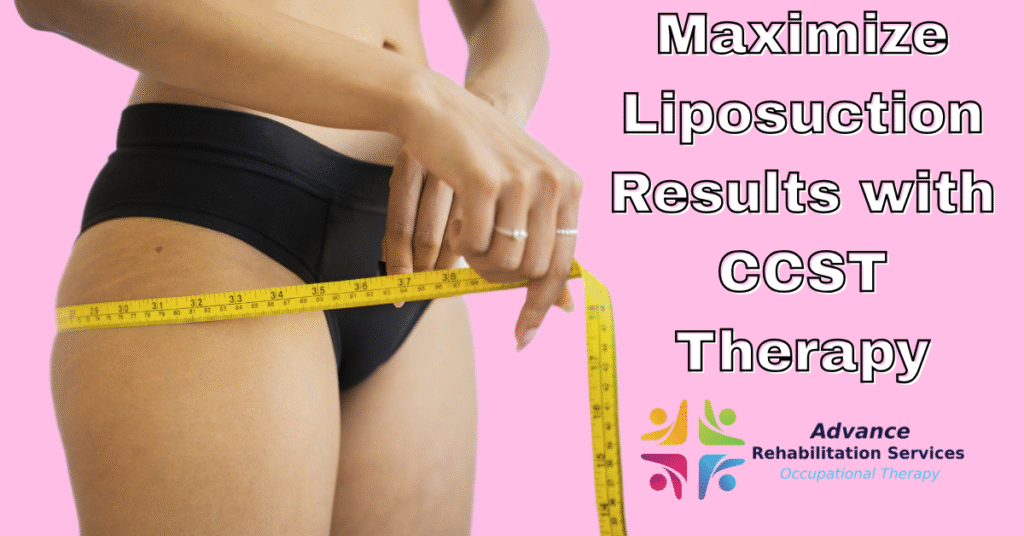At Advance Rehabilitation Services in Parsippany, New Jersey, we specialize in cosmetic surgery therapy, with therapists certified as Cosmetic Surgery Therapists (CCST) from the renowned Norton School of Lymphatic Therapy. If you’re considering or have recently undergone liposuction, you might be wondering how to optimize your recovery and achieve the best possible results. One key element that often gets overlooked is the role of specialized post-operative care. In this article, we’ll explore how working with a CCST can significantly enhance your liposuction outcomes, making your journey smoother and more effective.
Understanding Liposuction and the Need for Post-Operative Care
Liposuction is a popular cosmetic procedure designed to remove stubborn fat deposits and contour the body. While it’s minimally invasive compared to other surgeries, the body still undergoes significant changes during recovery. Swelling, bruising, and fluid buildup are common, and without proper management, these can lead to uneven results, prolonged discomfort, or even complications like fibrosis.
This is where post-liposuction recovery strategies come into play. Traditional recovery advice includes rest, compression garments, and light activity, but incorporating specialized therapies can take your results to the next level. A Certified Cosmetic Surgery Therapist, trained through programs like the Norton School of Lymphatic Therapy’s Cosmetic Surgery Therapy Certification Course, brings expertise in manual lymphatic drainage (MLD) and other techniques tailored for cosmetic surgery patients. These professionals focus on supporting the body’s natural healing processes, helping you heal faster and look better sooner.
What Is a Certified Cosmetic Surgery Therapist (CCST)?
A CCST is a healthcare professional, often with a background in occupational or physical therapy, who has completed advanced training in post-operative care for cosmetic procedures. The certification, offered by institutions like the Norton School of Lymphatic Therapy, equips therapists with skills in lymphatic massage, scar management, and inflammation reduction. This training emphasizes gentle, non-invasive techniques that promote lymph flow, which is crucial after surgeries like liposuction where the lymphatic system can become temporarily disrupted.
Unlike general massage therapists, CCSTs understand the unique needs of surgical patients. They use evidence-based methods to address issues specific to liposuction, such as fluid retention in treated areas like the abdomen, thighs, or arms. By choosing a CCST, you’re partnering with someone who knows how to safely accelerate recovery without risking complications.
Key Ways a CCST Improves Liposuction Outcomes
Working with a CCST during your post-liposuction recovery can lead to noticeable improvements in both comfort and aesthetics. Here are some of the primary benefits, backed by the principles of lymphatic therapy:
1. Reducing Swelling and Fluid Retention
One of the most immediate challenges after liposuction is swelling, which can make your new contours hard to appreciate right away. Lymphatic therapy, a cornerstone of CCST practice, gently stimulates the lymphatic system to drain excess fluid and waste products from the surgical site. This not only minimizes puffiness but also prevents seromas (fluid collections) that could require additional medical intervention.
Patients often report feeling lighter and more comfortable after just a few sessions. In fact, without this support, swelling might linger for weeks or months, delaying your return to normal activities.
2. Preventing Fibrosis and Improving Skin Texture
Fibrosis, or the formation of hard lumps and scar tissue, is a common concern post-liposuction. A CCST uses specialized massage techniques to break down these fibrous nodules early on, promoting smoother skin and more even results.
This leads to better skin tone and texture, helping you achieve that sculpted look you envisioned.
By addressing fibrosis proactively, CCSTs help avoid the “lumpy” appearance that can sometimes occur if healing is left to chance. This is especially beneficial for areas prone to unevenness, like the abdomen or flanks.
3. Alleviating Pain and Discomfort
Recovery doesn’t have to be painful. Lymphatic drainage massage from a CCST can reduce inflammation and nerve irritation, leading to less pain and a quicker return to daily life. Many patients find that these sessions provide a soothing, relaxing experience that complements pain management strategies recommended by your surgeon.
Enhanced circulation from the therapy also delivers more oxygen and nutrients to healing tissues, speeding up the overall process.
4. Flushing Toxins and Boosting Healing
During liposuction, fat cells are disrupted, releasing toxins and cellular debris into your system. A CCST’s techniques help flush these out efficiently, reducing the risk of infection and supporting your immune system.
This detoxification aspect can make you feel more energized during recovery, rather than sluggish.
Studies and clinical experiences show that regular lymphatic therapy post-surgery promotes faster tissue repair and more uniform healing, minimizing the chances of irregularities.
5. Personalized Care for Long-Term Results
Every patient’s body responds differently to liposuction, so a one-size-fits-all approach won’t cut it. CCSTs provide customized plans based on your procedure, body type, and recovery progress. This tailored support ensures that you’re not just recovering—you’re optimizing for the best long-term outcomes, including maintained contours and reduced risk of weight regain in treated areas.
When to Start Working with a CCST
Ideally, consult a CCST before your liposuction to discuss pre-operative preparation, but the real magic happens post-surgery. Most surgeons recommend starting lymphatic therapy within the first week, once initial healing allows. Sessions are typically gentle and can be scheduled 1-3 times per week, depending on your needs.
Remember, always coordinate with your plastic surgeon to ensure the therapy aligns with your overall recovery plan.
Final Thoughts on Enhancing Your Liposuction Journey
Incorporating a Certified Cosmetic Surgery Therapist into your post-liposuction recovery isn’t just an add-on—it’s a smart investment in your results. From reducing swelling and preventing complications to improving comfort and aesthetics, the benefits are clear and well-supported. If you’re ready to experience smoother, faster healing, consider reaching out to a qualified CCST.
For personalized cosmetic surgery therapy, contact our clinic in Parsippany, New Jersey, where our certified therapists from the Norton School of Lymphatic Therapy are here to support your transformation.

